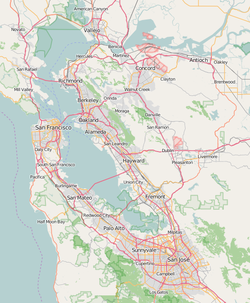Sanchez Adobe
|
Sanchez Adobe Park
|
|
 |
|
| Location | Linda Mar Blvd., 1 mi. E of CA 1, Pacifica, California |
|---|---|
| Coordinates | 37°35′18″N 122°29′38″W / 37.5882709°N 122.4938648°WCoordinates: 37°35′18″N 122°29′38″W / 37.5882709°N 122.4938648°W |
| Area | 5 acres (2.0 ha) |
| Built | 1785 |
| Architect | Multiple |
| Architectural style | Adobe–Spanish Colonial |
| NRHP Reference # | 76000525 |
| CHISL # | 391 |
| Added to NRHP | April 13, 1976 |
The Sánchez Adobe Park, home to the Sánchez Adobe, is located in Pacifica, California, at 1000 Linda Mar Boulevard, on the north bank of San Pedro Creek, approximately 0.91 miles (1,470 m) from the Pacific Ocean in Linda Mar Valley. The 5.46-acre (2.21 ha) county park, established in 1947 contains the Sanchez Adobe Historical site, designated a National Register Historical District in 1976 and is California registered landmark 391.
The park site has a long and rich history. The Sánchez Adobe at the park is considered the finest example of Mexican era architecture in San Mateo County. Archaeological and historical evidence identify four main periods of history, followed by the purchase of the site by the County of San Mateo in 1947.
Prior to 1786, the Ramaytush band of the Ohlone people had a settlement on the site, the village of Pruristac. Evidence of the village remains by a shell midden, located near the present day park ranger building. The Spanish explorer Gaspar de Portolà camped nearby in 1769, ~1 mile (1.6 km) to the west from 31 October through 3 November, during the Portolà expedition in upper Las Californias Province of New Spain. Journals from the expedition record of his group's meetings with the villagers, but give no indication that they visited the village.
The first indigenous person baptised at the Mission San Francisco de Asís (Mission Dolores) was the 20-year-old Chamis in 1777. He was from the Ohlone village of Chutchui, and his mother lived at Pruristac. In 1782 and 1783, many of the people in Pruristac, including the village captain Mossués and village leader Liquiique with their wives and daughters, went through Indian Reductions and relocated as Mission Indians to Mission Dolores. The mission was near the pueblo of Yerba Buena, which in 1847 become the city of San Francisco in Alta California. Two men of this group from Pruristac, with the baptismal names Hilarion and George, served as Indian leaders at Mission Dolores. They were alcades of the mission at the time of their deaths in 1807, while part of a Spanish posse during a skirmish with the Suisunes tribe.
...
Wikipedia



